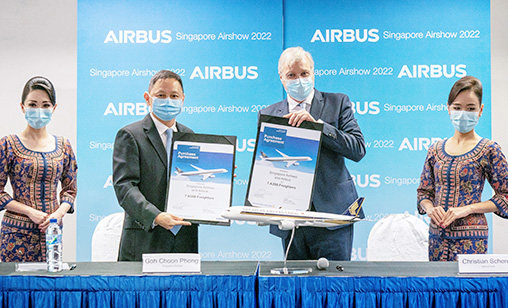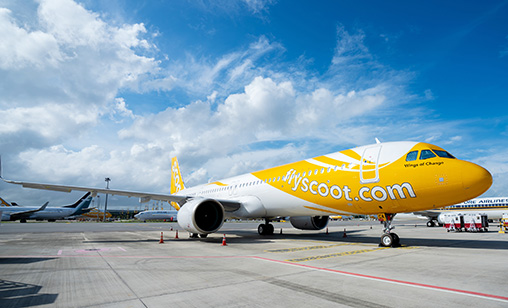News Backgrounder
Singapore leads region in airline recovery strategies
Location. Location. Location. It was the reason why, among the world’s carriers, Singapore Airlines has been one of the hardest hit by the pandemic. Yet throughout the crisis, the company’s CEO, Goh Choon Phong, has been determined the group will emerge stronger from COVID. Associate editor and chief correspondent, Tom Ballantyne, reports.
June 1st 2022
Last month, reflecting on the shattering impact of the global pandemic on the Singapore-headquartered carrier, SIA Group CEO, Goh Choon Phong, said: “The pandemic has been devastating for the airline industry, but even more so for an airline like SIA because we have no domestic market and are completely dependent on international operations.” Read More »
Speaking at an investor and media briefing in March, Goh recalled how the world quickly closed its borders when the COVID-19 pandemic emerged in late January 2020. “By April, we were operating at 3% of pre-COVID capacity. Worse was that our passenger carriage dropped from 3.4 million in January to a mere 11,000 people by April. Huge. Drastic. At that point in time, it was survival mode,” he said.
 |
| "KrisShop highlighted how SIA pivoted from pre-COVID to the present. Before COVID, most KrisShop sales were onboard sales. In fact, above 60% of revenue came from onboard sales. In the year just past, with very little flying, even without very many onboard sales, revenue for KrisShop sales in 2021-2022 was actually higher than pre-COVID" |
| Goh Choon Phong SIA group CEO |
In a detailed and frank briefing Goh conducted after the release of the airline’s results for the fiscal year to March 31, he described the corporate tightrope the airline group has had to walk not only to survive the pandemic but to grow beyond it.
The group’s losses for its latest fiscal year narrowed by 78%. The company also recorded a second half operating profit as passenger numbers leapt six-fold as travel restrictions were eased. An operating cash surplus of $600 million was achieved for the reported year.
While the group was still in the red for $444 million for the year, it was better by $1.38 billion (+75.7%) from the $1.8 billion loss in the year-ago period, with passenger revenue up by $1.5 billion, to $2 billion, for the 12 months. Cargo delivered a record $3.2 billion to SIA coffers for the year, driven by strong pricing in a period when air and shipping freight capacity could not meet demand.
Times may still be challenging, but the results were a dramatic turnaround from the dark days of 2020 when SIA was burning cash of up to $400 million a month - and that was before paying for aircraft scheduled for delivery to the group.
Goh, who took charge at SIA in January 2011, said the steep drop in passenger numbers and revenue was an extreme stress to the company in cash requirements, especially as the pandemic emerged just as SIA was completing a three-year transformation program.
Only months later, the group was faced with identifying sufficient sources of liquidity to fund basic operations.
“Fortunately,” Goh said, “we had strong support from our shareholders. We raised $10.9 billion from them. After that, and also from a strong statement of support from the Singapore government, we were able to go to many different sources of financing for additional funding. Accumulated funds raised since April 2020 amount to $16.3 billion, which gave us one of the strongest balance sheets among all airlines.”
The fund raising exercise was a learning experience. “We had never had a need to reach out to so many different sources of funding. In the process, we learned a lot about how best to actually organize the process of getting those funds,” he said.
 |
“What are the preparations we need to make? How do we make assessments of the viability of those funding sources? This learning [curve] helped us. One of the results of it is we are much stronger and more resilient.
“Not that we want another crisis of this nature. Should something happen of a similar nature that would demand a lot of cash in the short term, we are equipped with the necessary knowledge to respond even more effectively.”
But it was not all about funding, Goh said. “We took rapid and practical steps to reduce our expenditure. Part of this was working with the OEMs to defer some of the payments we had to make,” he said. “Again, we were one of the earliest airlines to reach out to our major OEMs to negotiate the deferral of aircraft deliveries. As a consequence, we moved out more than $2.9 billion of aircraft capital expenditure in the immediate term.”
SIA group staff also had to make sacrifices. “Besides taking pay cuts, we had to go through a very painful exercise to reduce our staff strength. We have consistently said our people are our greatest and most valuable asset,” Goh said.
“It’s the reason why, in this area of letting go staff, we were probably among the latest [to do so] among airlines.”
SIA, realizing it would be difficult for people to find new jobs, essentially seconded 2,000 staff to public and private sector organizations in Singapore where they worked, on full pay, as “ambassadors” in areas such as hospitals, transport and safe distancing.
 |
“This pandemic, like all the crises we have gone through, will pass at some point. We need the ability to bounce back as quickly as possible when that happens.
“At the same time, these people were contributing to the efforts to deal with the pandemic and that generated a lot of good will. Also, they were learning new skills. They know they can come back to SIA when we see a recovery. From a company point of view, we are getting back skilled people who have actually acquired new skills.”
Goh said SIA has become more innovative because of the pandemic. “We have had to be. We know health and safety have become such important considerations for everyone. People wanted to reduce contact so we quickly leveraged on the investment we had made before the pandemic,” he said.
“The digital investment introduced ways our customers could interact with us without necessarily having physical contact. Inflight reading can be done on personal devices. Similarly, passengers could use their own devices to control IFE on board.
“We were in a situation where nobody was flying, but we had to continue to engage with our customers. Our people found novel ways to do this such as the A380 restaurant experience. It had an overwhelming response. We planned two sessions and ended up having to organize 15.
“We also introduced a scent from flowers indigenous to Singapore that we sold on the airline’s online KrisShop site.”
Onboard, the group launched a catering product, the Bento service, which uses recyclable paper products. It not only cuts weight, but reduces annual carbon emissions by 2,000 tonnes.
| "At the end of 2019, we were coming out of a three-year transformation exercise with all cylinders firing. We were achieving in that quarter - October to December 2019 - record revenue, record passenger carriage, one of the highest load factors we had ever had and one of the best operating profits for the quarter" |
Fleet development is another part of SIA’s strategy, particularly sustainability. The average age of the SIA group fleet at May 31 was six years and two months compared with the average global fleet age of 15 years and four months.
Some 63% of the SIA group’s aircraft are new generation and the airline company has firm orders for 107 more, including seven A350Fs scheduled for delivery from the fourth quarter of 2025. The new airplanes will replace the 747-400F fleet and burn up to 40% less fuel. SIA is on track to be the first airline company to operate the type.
Goh continued: “When we compare ourselves with other airlines in Asia, we have been driving up capacity way ahead of our peers, especially in this part of the world, bearing in mind we are talking about international operations.”
He also stressed SIA is continuing to transform. “This is the second year of our new transformation exercise. The focus is on teaching our people to be even more productive, to reskilling, to up skilling and to introduce more innovation and workflow adjustments to make us more effective.
“We will continue to improve our products. All the A380s operating today are fitted with the latest A380 product. We have introduced new product on our narrow-bodies and the 737 MAX and will continue to invest in making the customer experience better.”
In the final quarter of the reported year, SIA took delivery of one A350-900 in January and three B737-8s that are to enter service with the group.
Additionally, 100% subsidiary, Scoot, has accepted the A321neo type into its operating fleet. At March 31, the full-service SIA operating fleet was 123 passenger aircraft and seven freighters. Scoot had 53 passenger aircraft at the same date.
For the reported year, the group’s passenger network served 93 destinations in 36 countries and territories, up from 85 destinations at December 31, 2021. In pre-COVID times, the group was flying to 137 destinations in 37 countries and territories – SIA to 69 destinations and Scoot to 43 destinations. The cargo network has expanded to 100 cities, up from 98 at year-end last year.
Based on published schedules, the Group has forecast passenger capacity will reach 61% of pre-COVID levels in the first quarter of 2022-2023.
As travel demand recovers, the SIA group expects passenger capacity to achieve around 67% of pre-COVID levels by September 30 and serve more than 70% of its pre-pandemic destinations in the same time frame.
It also will continue to focus on its network and increase connectivity. As well as expanding its codeshare agreement with United Airlines and collaborating more deeply with All Nippon Airways, SIA Group has written new agreements with Malaysia Airlines Berhad and Garuda Indonesia.
If there is a concern for SIA going forward it is inflationary pressure, in particular the impact of rising fuel prices on its cost structure. In fiscal year 2021-2022, the average jet fuel price was $90.31 per barrel (before hedging). Since then, spot prices are more than 50% higher and were close to $150 per barrel early last month.
In the past year, net fuel costs at the SIA Group increased by $853.4 million, or 115.5%, to $1.6 billion.
But for Goh the path ahead is a lot brighter than it was two years ago. “The SIA Group will remain agile and leverage opportunities to reinforce its leadership position in the airline industry,” he said.
Carlos Saldivia says:
July 30th 2024 02:15am